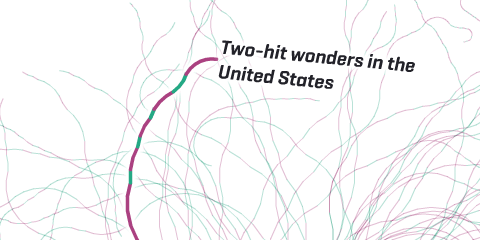Notabilia — Visualizing Deletion Discussions on Wikipedia
Just in time for Wikipedia’s forthcoming tenth anniversary (congrats!), two researchers – Dario Taraborelli and Giovanni Luca Ciampaglia – approached me for a cooperation on visualizing the discussions around article deletions on Wikipedia. The (intermediate?) results are online at notabilia.net.

I came up with a tree visualization, where Article for Deletion discussion is represented by a thread starting at the bottom center. Each time a user recommends to keep, merge, or redirect the article a green segment leaning towards the left is added. Each time a user recommends to delete the article a red segment leaning towards the right is added. As the discussion progresses, the length of the segments as well as the angle slowly decay.
In the visualizations, I tried to capture the tension between chaos and order inherent to the discussions, and provide a nice serendipity interface as well.
So much to learn about…
 …or…
…or…
 …and…
…and…
But also some more hard analysis can be found at notabilia.net, looking at the vote distributions, lengths of discussions, etc. Take a look yourself!
January 10th, 2011 at 12:24 pm
Very nice concept! Would love to see this visualization animated :-)
January 11th, 2011 at 6:58 pm
Notabilia – Visualizing Deletion Discussions on Wikipedia…
To celebrate Wikipedia’s 10th Birthday Notabilia investigates the “Article for Deletion” discussions by the editors. The two interactive visualizations show the 100 longest discussions about articles that eventually got kept or delete…
January 13th, 2011 at 12:30 pm
Wow, another wonderful project. Always awed by the work you do!
I especially like the beautiful logarithmic spirals representing Keep-Keep-Keep articles.
June 6th, 2012 at 3:01 pm
[…] Notabilia – Visualizing Wikipedia deletion discussions […]
April 5th, 2014 at 4:59 pm
He died in 1985 but this very personal museum is often a lasting reminder of a very remarkable man.
Mostly a brief history of business was able to control
various inventions and technologies. Body Language is nonverbal, usually unconscious, communication
by using postures, gestures, and facial expressions.